On this page
Pigeons and DovesThis page lists books about pigeons and doves. The books are listed by publication date with the most recent at the top.
Passenger Pigeon
For books about the Passenger Pigeon see;
Passenger Pigeons
Pigeons & Doves
Family: Columbidae
In the UK
Wood Pigeon
(Common Wood Pigeon)
Columba palumbus
Stock Dove
(Stock Pigeon)
Columba oenas
Rock Dove
Columba livia
Collared Dove
(Euroasian Collared Dove)
Streptopelia decaocto
Turtle Dove
(European Turtle Dove)
Streptopelia turtur
Other pigeons and doves
There are over 300 other species of pigeons and doves worldwide.
|
|
|
|
Pigeons and Doves in AustraliaJoseph M. Forshaw
Illustrations: William T. Cooper
CSIRO
2015
"From dense rainforests of north Queensland, where brilliantly plumaged Superb Fruit-Doves Ptilinopus superbusare heard more easily than seen, to cold, windswept heathlands of Tasmania, where Brush Bronzewings Phaps elegans are locally common, most regions of Australia are frequented by one or more species. For more than a century after arrival of the First Fleet, interest in these birds focused on the eating qualities of larger species. In addition to contributing to declines of local populations in some parts of Australia, excessive hunting brought about the extinction of two species on Lord Howe Island and another species on Norfolk Island. In Pigeons and Doves of Australia, Joseph Forshaw and William Cooper have summarised our current knowledge of all species, including those occurring on Christmas, Norfolk and Lord Howe Islands, and with superb artwork have given readers a visual appreciation of the birds in their natural habitats. Historical accounts of extinct species are also included. Detailed information on management practices for all species is presented, ensuring that Pigeons and Doves in Australia will become the standard reference work on these birds for ornithologists and aviculturists."
|
Buy from amazon.co.uk 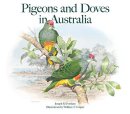
|
|
A Feathered River Across the Sky: The Passenger Pigeon's Flight to ExtinctionJoel Greenberg
Bloomsbury
2014
"In the early nineteenth century 25 to 40 percent of North America's birds were passenger pigeons, traveling in flocks so massive as to block out the sun for hours or even days. The down beats of their wings would chill the air beneath and create a thundering roar that would drown out all other sound. Feeding flocks would appear as 'a blue wave four or five feet high rolling toward you.' As naturalist Joel Greenberg relates in gripping detail, the pigeons' propensity to nest, roost, and fly together in vast numbers made them vulnerable to unremitting market and recreational hunting. The spread of railroads and telegraph lines created national markets that allowed the birds to be pursued relentlessly. Passenger pigeons inspired awe in the likes of Audubon, Henry David Thoreau, James Fenimore Cooper, and others, but no serious effort was made to protect the species until it was way too late. Greenberg's beautifully written story of the passenger pigeon provides a cautionary tale of what happens when species and natural resources are not harvested sustainably."
|
Buy from amazon.co.uk 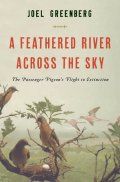
|
|
The Passenger PigeonErrol Fuller
Princeton University Press
2014
"This stunningly illustrated book tells the astonishing story of North America's Passenger Pigeon, a bird species that--like the Tyrannosaur, the Mammoth, and the Dodo--has become one of the great icons of extinction. Errol Fuller describes how these fast, agile, and handsomely plumaged birds were immortalized by the ornithologist and painter John James Audubon, and captured the imagination of writers such as James Fenimore Cooper, Henry David Thoreau, and Mark Twain. He shows how widespread deforestation, the demand for cheap and plentiful pigeon meat, and the indiscriminate killing of Passenger Pigeons for sport led to their catastrophic decline. Fuller provides an evocative memorial to a bird species that was once so important to the ecology of North America, and reminds us of just how fragile the natural world can be. Published in the centennial year of Martha's death, The Passenger Pigeon features rare archival images as well as haunting photos of live birds."
|
Buy from amazon.co.uk 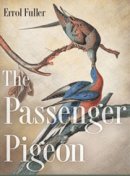
|
|
Pilgrims of the Air: The Passing Of The Passenger PigeonJohn Wilson Foster
Notting Hill Editions
2014
"This is a story of a scarcely credible abundance, of flocks of birds so vast they made the sky invisible. It is also a story, almost as difficult to credit, of a collapse into extinction so startling to the inhabitants of the New World as to provoke a mystery. In the fate of the North American passenger pigeon we can read much of the story of wild America - the astonishment that accompanied its discovery, the allure of its natural 'productions', the ruthless exploitation of its 'commodities' and the ultimate betrayal of its peculiar genius. And in the bird's fate can be read, too, the essential vulnerability of species, the unpredictable passage of life itself."
|
Buy from amazon.co.uk 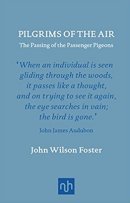
|
|
A Message from Martha: The Extinction of the Passenger Pigeon and Why it Still MattersMark Avery
Bloomsbury
2014
"September 1st, 2014 marked the centenary of one of the best-documented extinctions in history - the demise of the Passenger Pigeon. From being the commonest bird on the planet 50 years earlier, the species became extinct on that fateful day, with the death in Cincinnati Zoo of Martha - the last of her kind. This book tells the tale of the Passenger Pigeon, and of Martha, and of author Mark Avery's journey in search of them. It looks at how the species was a cornerstone of the now much-diminished ecology of the eastern United States, and how the species went from a population that numbered in the billions to nil in a terrifyingly brief period of time. It also explores the largely untold story of the ecological annihilation of this part of America in the latter half of the 19th century, a time that saw an unprecedented loss of natural beauty and richness as forests were felled and the prairies were ploughed, with wildlife slaughtered more or less indiscriminately. Despite the underlying theme of loss, this book is more than another depressing tale of human greed and ecological stupidity. It contains an underlying message - that we need to re-forge our relationship with the natural world on which we depend, and plan a more sustainable future. Otherwise more species will go the way of the Passenger Pigeon. We should listen to the message from Martha."
|
Buy from amazon.co.uk 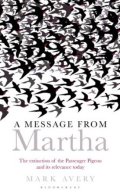
|
|
The Global PigeonColin Jerolmack
University of Chicago Press
2013
"The pigeon is the quintessential city bird. Domesticated thousands of years ago as a messenger and a source of food, its presence on our sidewalks is so common that people consider the bird a nuisance - if they notice it at all. Yet pigeons are also kept by people all over the world for pleasure, sport, and profit, from the "pigeon wars" waged by breeding enthusiasts in the skies over Brooklyn to the Million Dollar Pigeon Race held every year in South Africa. Drawing on more than three years of fieldwork across three continents, Colin Jerolmack traces our complex and often contradictory relationship with these versatile animals in public spaces such as Venice's Piazza San Marco and London's Trafalgar Square and in working-class and immigrant communities of pigeon breeders in New York and Berlin. By exploring what he calls "the social experience of animals," Jerolmack shows how our interactions with pigeons offer surprising insights into city life, community, culture, and politics."
|
Buy from amazon.co.uk 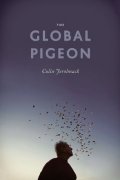
|
|
The Pigeon in the Wider WorldJean Hansell
Millstream Books
2010
"This profusely illustrated book examines the role of the pigeon in the daily life and cultural thought of many different civilisations across the world. From the ancient Middle East and Classical Greece and Rome, to both historical and modern examples from Egypt, India, Iran and China, the author covers a panoply of practices and beliefs. Further chapters cover topics such as the uses and status of the pigeon along the course of the Silk Road, and the history of the bird as a messenger, ranging from Noah to heroic flights as part of the British army in both World Wars. The fruit of many years of research by an accomplished author, this book reveals many fascinating insights into different societies and is certain to appeal to all keen social historians as well as ornithologists, students of religion and pigeon fanciers."
|
Buy from amazon.co.uk 
|
|
PigeonBarbara Allen
Animal series
Reaktion Books
2009
240 pages, 70 colour illustrations, 30 other illustrations
"Pigeon is an exploration of the natural and cultural history of the pigeon, and the evolution of its relationship with humanity through the ages. Written out of love and fascination with a humble yet important bird, Pigeon relates its cultural significance, as well as its similarities and differences to its close counterpart, the dove. While the dove is seen as a symbol of love, peace, and goodwill, the pigeon is commonly perceived as filthy and ill-mannered, a 'rat with wings'. To say the least, the pigeon has a bad reputation, but Barbara Allen offers several examples of the bird's importance - from a source of food and fertilizer, and a bearer of messages during times of war; to a pollution monitor and an aid to Charles Darwin in his pivotal research on evolutionary theory. She goes on to connect pigeons and doves with writers and poets from Shakespeare, Dickens, and Browning, to Beatrix Potter, Proust and I. B. Singer, who she shows have all celebrated the birds' beauty and attributes. Readers will find in Pigeon an enticing exploration of the historical and contemporary bonds between humans and these two unique and closely-related birds, bonds which have been in existence since their domestication over 3,000 years ago. Allen intends to correct the many stereotypes about pigeons and doves with hopes that the rich history of the relationship and the acknowledgement of what is one of the oldest human-animal partnerships will be both admired and celebrated."
|
Buy from amazon.co.uk 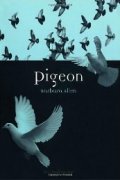
|
|
Superdove: How the Pigeon Took Manhattan ... and the WorldCourtney Humphries
Harper Collins
2008
"Why do we see pigeons as lowly urban pests and how did they become such common city dwellers? Courtney Humphries traces the natural history of the pigeon, recounting how these shy birds that once made their homes on the sparse cliffs of sea coasts came to dominate our urban public spaces. While detailing this evolution, Humphries introduces us to synanthropy: The concept that animals can become dependent on humans without ceasing to be wild; they can adapt to the cityscape as if it were a field or a forest."
|
Buy from amazon.co.uk 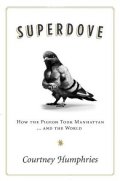
|
|
Band-tailed Pigeon: Wilderness Bird at RiskWorth Mathewson
Timber Press
2005
"Some attribute the bird's decline to habitat loss, but Mathewson, in this complete natural history, carefully builds his case to the contrary. While trichomoniasis and spraying of broadleaf trees may contribute, the human factor is paramount: a persistently callous attitude toward Patagioenas fasciata may keep it in a downward spiral. If modest protections are lifted at the first signs of recovery, its fate may be sealed. With drawings by noted wildlife artist David Hagerbaumer, color photographs by the author and Margaret Thompson Mathewson, and an extensive bibliography, this finely rendered, affecting portrait of a wild bird with a troubled past is nothing short of a call to action."
|
Buy from amazon.co.uk 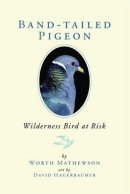
|
|
Avian Navigation: Pigeon Homing as a ParadigmHans G Wallraff
Springer-Verlag
2004
"This monograph summarizes our current knowledge about pigeon homing, about the birds' application of a sun compass and a magnetic compass, of a visual topographical map within a familiar area and - most surprisingly - of an olfactory map using atmospheric chemosignals as indicators of position in distant unfamiliar areas."
|
Buy from amazon.co.uk 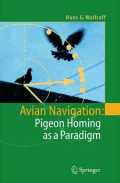
|
|
Images of the DoveJean Hansell
Millstream Books
2003
This is illustrated work, which includes over 200 color and 150 black and white illustrations, is a study of the Dove in the art of ancient civilization and modern times.
|
Buy from amazon.co.uk 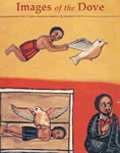
|
|
Pigeons and Doves: A Guide to the Pigeons and Doves of the WorldDavid Gibbs, Eustace Barnes and John Cox
Pica
2000
"Pigeons and doves are a large family of birds occurring throughout the world. This book - the first to be dedicated to the field identification of these birds and to be fully illustrated in color-incorporates much recent information about them. Many species of pigeons and doves are specialist frugivores, say the authors, while others feed on seeds. Most are arboreal, and the tropical species in particular are often brightly colored. The family includes gregarious migratory species as well as shy, ground-dwelling forms such as the exotic crowned pigeons of New Guinea. The comprehensive text is accompanied by 76 exquisite color plates that capture the essence of these varied birds and illustrate all species and subspecies." From inside flap of book.
|
Buy from amazon.co.uk 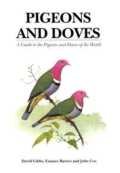
|
|
The Silent Sky: The Incredible Extinction of the Passenger PigeonAllan W. Eckert
iUniverse.com
2000
The story of the destruction of the Passenger Pigeon.
|
Buy from amazon.co.uk 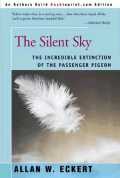
|
|
The Pigeon In HistoryJean Hansell
Millstream Books
1998
An exploration of the relationship between man and pigeon from the earliest civilisations to the present day.
|
Buy from amazon.co.uk 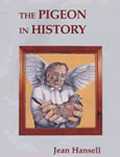
|
|
PigeonsDorothy Hinshaw Patent
Houghton Mifflin
1997
This book describes the physical characteristics, behaviour and usefulness to man of the pigeons.
|
Buy from amazon.co.uk 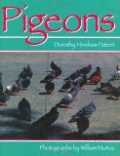
|
|
Feral PigeonsRichard F. Johnston
Oxford University Press
1995
A work that focuses on population biology and behavioural ecology of Feral Pigeons, and includes a very thorough listing of primary references in the scholarly literature. Contents: Part I: History and systematic biology; Introduction; Size, shape, and genetic variation in pigeon populations; Part II: Reproductive biology and diet; Breeding seasons in feral pigeons; Mate choice and pair bonding; Nestsites and nestbuilding; Eggs; Brood Reduction; Development: nestlings; Development: fledglings; Diet; Part III: Plumage and flight; Plumage polymorphism; Maintenance and molt of plumage; Flight; Part IV: Behavior; Social Behavior; Pigeon colonies; Orientation and navigation; Part V: Population studies; Reproductive success and mortality; Abundance and density; Part IV: Some environmental concerns; Heavy metals and other pollution; Aspects of the biotic environment; Control of pigeon populations; Part VII: People and pigeons.
|
Buy from amazon.co.uk 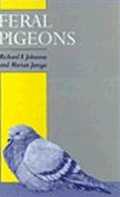
|
|
Ecology and Management of the Mourning DoveT. Baskett
Stackpole Books
1993
|
Buy from amazon.co.uk 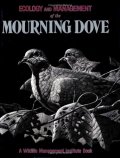
|
|
Parrots and Pigeons of AustraliaEditor: Francis Crome and James Shields
Birds Of Australia series
The National Photographic index of Australian Wildlife
Angus & Robertson
1992
"This is an account of all the species of parrots and pigeons found in Australia. The text is designed for the general reader with no prior knowledge of the birds that are dealt with. Each entry provides a summary of what is known about the basic biology of the species, its habitat and distribution. Each species is illustrated and each photograph is chosen for its technical, scientific and aesthetic qualities."
|
Buy from amazon.co.uk 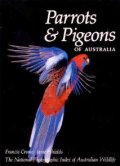
|
|
Life of the PigeonAlexander F. Skutch
Illustrations: Dana Gardner
Cornell University Press
1991
This work describes pigeon behaviour and ecology, as well as pigeons' special relationship with man, particularly their ability as homing pigeons.
|
Buy from amazon.co.uk 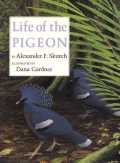
|
|
Migration, Harvest, and Population Characteristics of Mourning Doves Banded in the Western Management Unit 1964-1977Roy E. Tomlinson et al
U.S. Department of Interior
1988
|
 |
|
Pigeons and Doves of the WorldDerek Goodwin
British Museum Natural History / Cornell University Press
3rd edition
1983
363 pages with 6 colour plates (3 new for this edition) and many line drawings and maps.
|
Buy from amazon.co.uk 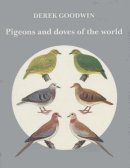
|
|
Physiology and Behaviour of the PigeonMichael Abs
Academic Press Inc
1983
|
Buy from amazon.co.uk 
|
|
Pigeons and Doves of AustraliaH.J. Frith
Rigby Publishers
1982
Guide to the 25 species of pigeons and doves of Australia. Text supported by colour plates showing all plumages, sonograms, and distribution maps.
|
Buy from amazon.co.uk 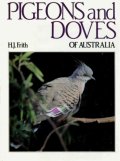
|
|
Population Level And Nesting Biology Of The Stock Dove Columba Oenas In Great Britain, 1930-1980O'Connor, R.J. & Mead, C.J.
Research report 5
British Trust for Ornithology
1981
47 page report.
|

|
|
The Public Life of the Street PigeonEric Simms
Hutchinson
1979
The natural (and human) history of the feral pigeon.
|
Buy from amazon.co.uk 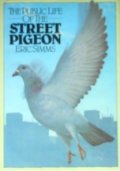
|
|
Pigeons and Doves of the WorldDerek Goodwin
Cornell University Press
2nd edition
1977
US publication of the second edition originally published in the UK in 1970. 446 pages with 3 colour plates and many line drawings and maps.
|
Buy from amazon.co.uk 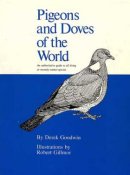
|
|
The Passenger Pigeon: Its Natural History and ExtinctionA.W. Schorgen
University of Oklahoma Press
1973
A study of the Passenger Pigeon based on detailed research. Includes information on behavioral characteristics, feeding methods, traveling and roosting habits, and nesting. Describes the relationship between the bird and man from its use by Native Americans to its destruction by white settlers.
|
Buy from amazon.co.uk 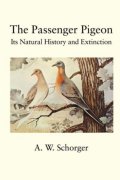
|
|
Whitewings: The Life History, Status And Management Of The White-Winged DoveEditor: Clarence Cottam and James B. Trefethen,
D. Van Nostrand Company
1968
|
Buy from amazon.co.uk 
|
|
Seven New White-Winged Doves From Mexico, Central America, And The Southwestern United States
George B. Saunders
North American Fauna, Number 65
Bureau Of Sports Fisheries And Wildlife
US Department Of The Interior
1968
From the introduction: The present paper describes seven new subspecies. Apparently, ornithologists have assumed that asiatica is the resident form in much of Central America because their collections, made mostly in the autumn and winter months, include so many of this race; other white- wings have been lumped as asiatica with the observation that this race shows wide variation (Dickey and van Rossem, 1938; Griscom, 1932; and Ridgway, 1916) . While many asiatica winter as far south as Costa Rica, they do not breed in Central America (Saunders, 1959, 1962). It now appears that the race asiatica is much less variable in color and size than was formerly believed. My interest in this problem began in 1910 when some of the whitewing nestlings we banded in southern Texas in summer were reported during autumn and winter in Guatemala and El Salvador. In 1942 I visited these countries for the first time during winter and spring to study the numbers and distribution of these doves and the factors affecting them.
|
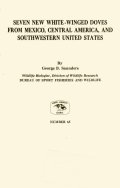
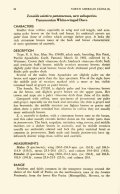 |
|
Pigeons and Doves of the WorldDerek Goodwin
British Museum (Natural History)
1967 (2nd edition in 1970)
446 pages with 3 colour plates and many line drawings and maps.
|
Buy from amazon.co.uk 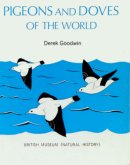
|
|
The Collared DoveHumphrey M. Dobinson
Illustrations: Robert Gillmor
Longmans
1966
|
 |
|
The Wood PigeonR K.Murton
Collins
The New Naturalist Monograph 20
1965
A 56 page study of the Wood Pigeon which includes discussion of crop damage and control, patterns of migration, breeding habits, food sources, diseases and life-span. Includes colour and black and white photographs and graphs and charts.
|
Buy from amazon.co.uk 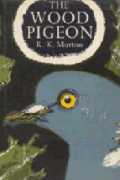
|
|
Wild Pigeons & DovesJean Delacour
All-Pets Books
1959
Reprinted in 1980 by TFH Publications.
|
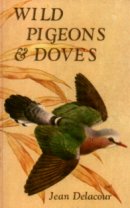
1959 edition
Buy from amazon.co.uk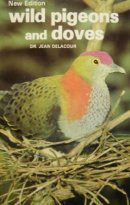
1980 edition
|
|
Habits, Food, And Economic Status Of The Band-Tailed Pigeon
Johnson A. Neff
North American Fauna, Number 58
Fish And Wildlife Service
US Department Of The Interior
1947
From the abstract: Information is compiled for use in conserving and managing the band-tailed pigeon, largest native member of the family Columbidae in the United States. The report deals with the discovery of the bird and its appearance, distribution, migration, life history, nesting, habits, and game status, and contains a discussion of factors governing its abundance. Original information is presented on food habits, based on the laboratory analyses of 691 stomachs and/or crops of these birds. Mast (acorns and pine nuts) was found in 268 of the specimens and constituted 50.1 percent of the annual food. The availability of mast for food largely determines the migration routes and wintering habitat, and indirectly determines the nature and extent of damage inflicted by these birds upon crops. The fondness of the band-tail for cultivated cherries and small green prunes forms the basis for many agricultural com- plaints. These fruits were found in 98 birds and made up 11 percent of the diet. Other fruits tff the rose family taken by the birds included those of blackberry, salmonberry, serviceberry, toyon, and hawthorn, together making up 13.6 percent of the annual food.
|
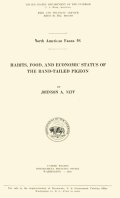
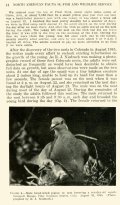 |
|
Catalogue Of The Columbae or Pigeons In The Collection Of The British MuseumCatalogue Of The Birds In The British Museum, Volume XXI
T. Salvadori
15 colour plates: J.G. Keulemans
Printed By Order Of The Trustees
Sold by: Longman & Co.; B. Quaritch; Kegan Paul, Trench, Trubner & Co.; and at the British Museum (Natural History)
1893
Preface: "The Collection of Pigeons in the British Museum consists of 7359 specimens, referred by the Author to 415 species. Only about one tenth of the species known are unrepresented in the Collection; they belong chiefly to the Austro-Malayan and Polynesian Faunas; whilst of other species the series of specimens are almost complete, having been obtained from the donations of Mr. A. Hume, and especially of Messrs. Godman and Salvin, who were collecting specimens of Pigeons for many years with the view of preparing a completely illustrated Monograph of the Order. I have again the pleasure of acknowledging the conscientious attention which the Author has given to this work in all its details, and which renders it a worthy companion to the preceding volume of this Catalogue."
|
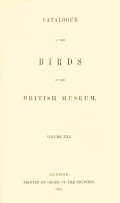
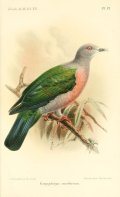
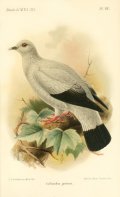 |
|
On the Polynesian Members of the Genus Ptilopus
Lionel W. Wiglesworth
Colour plate (Ptilopus clementinae): J.G. Keulemans
Ibis: Volume 33, Issue 4, pages 566-584
1891
Opening lines: "The Pigeons of the genus Ptilopus, as distributed among the islands of Polynesia, exemplify on a remarkable scale the formation of new species by geographical separation, which is shown in such a striking manner in the Parrots, Blackbirds, and Rhipidurae of the Fiji Islands, and above all in the well-known Land-shells of the family Achatinellidae of the valleys of Oahu. In these cases, however, a narrow projecting mountain-ridge or a few miles of sea are sufficient to prevent the species from interbreeding and losing their identity- as no doubt they would for the most part, could they pass freely from one locality to another; but with the genus Ptilopus a stretch of unbroken ocean 200 or 300 miles wide is required to serve the same end, in consequence of the good powers of flight of these birds."
|
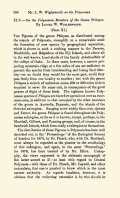
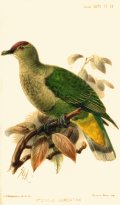 |
|
Pigeons of AustraliaGracius J. Broinswski
1888
11 colour plates with accompanying text. Uncertain if this was published as a book or as a set of loose plates. Sets of the plates have been subsequently bound. The plates had been prepared for the proposed publication Birds Of Australia.
|
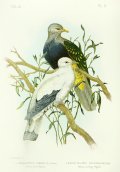
|
|
The Natural History Of Pigeons
Prideaux John Selby
Colour plates: Edward Lear
Naturalistís Library, Volume IX
W.H. Lizars
1835
Opening lines: "The Pigeons, or family of the Columbidae, which furnish the materials for the present volume, are now, in accordance with their true affinities, admitted into the order of the Rasores, or Gallinaceous Birds, of which they form one of the five groups or divisions, the other four being represented by the Pavonidae, Tetraonidae, Struthionidae and Tetraonidae."
|
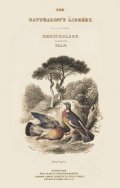
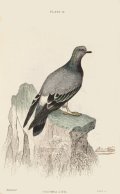 |
|